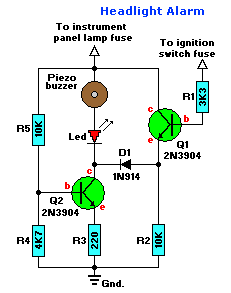Headlight Alarm
"Never forget to turn off your head light ever again! Most newer cars already have this
feature built-in but there are still lots of cars out there without it. This simple circuit is cheap and can be built for
about $5 bucks!"
 It's 5:00pm and you've just finished a long
day at the office. You climb into your car, turn the ignition switch on, and nothing happens. That's when you
suddenly realize the problem; you left your headlights on this morning. Unfortunately, the realization has come
about eight hours too late and now your battery is dead.
It's 5:00pm and you've just finished a long
day at the office. You climb into your car, turn the ignition switch on, and nothing happens. That's when you
suddenly realize the problem; you left your headlights on this morning. Unfortunately, the realization has come
about eight hours too late and now your battery is dead.
The preceding incident has probably happened to your at least once; in my case it has happened more often than I care
to remember. Or at least it used to. Now, I have installed the simple circuit shown in Fig. 1 in my car. Of course,
the circuit is a headlight alarm. It has saved me from embarrassment and aggravation on several occasions.
The Circuit: While many cars are equipped with a headlight alarm, many more, unfortunately are not. For those
cars this little circuit offers a low-cost way to add that valuable feature. Let's see how it works.
The base of Q1 is connected to the car's ignition circuit; the easiest point to make that connection is at the
ignition switch via the fuse panel. Also, one side of the piezoelectric buzzer is connected to the instrument-panel
light fuse; remember that when the headlights or parking lights are on, the instrument panel is lit too. When the
headlights are off, no current reaches the buzzer and therefore nothing happens. What happens when the headlights
are on depends on the state of the ignition switch. When the ignition switch is on, transistors Q1 and Q2 are biased
on, effectively removing th buzzer and the LED from circuit.
When the ignition switch is turned off but the headlights are on, transistor Q1 is turned off, but transistor Q2
continues to be biased on. The result is that the voltage across the piezoelectric buzzer and the LED is sufficient to
cause the buzzer to sound loudly and the LED to light. Turning off the headlight switch will end the commotion
quickly.
Construction:The circuit can be wired together on a piece of perf-board. The buzzer I used was a Radio Shack
273-065 PC-board mounting type, but almost any similar buzzer will do. Circuit parameters are not critical, so feel
free to make appropriate substitutions from your junk box to further reduce the cost.
When your are finished, house the circuit in a small, plastic experimenter's box (in my case a plastic film container)
and locate the unit on or under the dash where it will be out of the way and mount only the LED where it can be seen
easily. One good place would be next to the headlight switch on the dash; that will provide more of a custom look.
Page Copyright © 1995 - Tony van Roon
Project Copyright © January 1989, by Charlie Lowell
 It's 5:00pm and you've just finished a long
day at the office. You climb into your car, turn the ignition switch on, and nothing happens. That's when you
suddenly realize the problem; you left your headlights on this morning. Unfortunately, the realization has come
about eight hours too late and now your battery is dead.
It's 5:00pm and you've just finished a long
day at the office. You climb into your car, turn the ignition switch on, and nothing happens. That's when you
suddenly realize the problem; you left your headlights on this morning. Unfortunately, the realization has come
about eight hours too late and now your battery is dead.